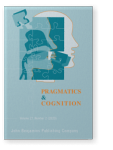Vol. 27:2 (2020) ► pp.457–473
An experimental study of the detection of clicks in English
This experimental study sets out to determine whether people detect click sounds in American English. Recent research has documented the use of non-phonemic clicks in a variety of languages to fulfill a range of functions such as sequence management or signaling searches and different types of attitudinal stance. While these clicks are acoustically salient and have been reported to occur with a frequency of up to 14 per minute in British English, they have not been widely investigated until relatively recently. For this experiment, we designed video stimuli consisting of A and B pairs of approximately 10 seconds of speech, one with a click and the other with the click edited out. We gave 118 participants a questionnaire and asked if they could detect a difference between the pairs of videos. The results indicate that the majority of participants, between 79% and 86%, do not detect click sounds.
Article outline
- 1.Introduction
- 2.Background
- 3.Method
- 3.1Participants
- 3.2Video stimuli
- 3.3Preliminary experiments
- 3.3.1Edit detection
- 3.3.2Pilot
- 3.4Instrument and procedure
- 3.5Data coding and analysis
- 3.6Research hypotheses
- 4.Results
- 4.1Quantitative
- 4.2Qualitative
- 5.Discussion
- 6.Conclusion
- Acknowledgements
-
References
